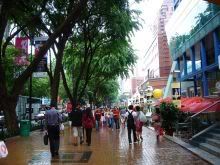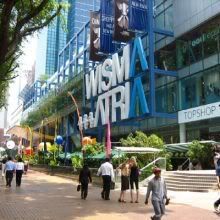Joel Tan / Writer
The minute something interesting and distinctive begins to develop in the heart of town, we pull out our guns and go “shoot the eyesore”.
 A few weeks ago, I opened up the Lifestyle section of the Straits Times on Sunday to read some food reviews, when I chanced upon an article by Cara Van Miriah. Titled “Oh my, is this Orchard Road?” (ST 5th October 2008), the article examines the “infestation” of our beloved shopping belt by buskers, foreign workers, touters, makeshift stalls and other such miscreants, all of whom the article suggests tarnish the image Orchard Road has (ostensibly) built up for itself as a swanky, world class shopping belt.
A few weeks ago, I opened up the Lifestyle section of the Straits Times on Sunday to read some food reviews, when I chanced upon an article by Cara Van Miriah. Titled “Oh my, is this Orchard Road?” (ST 5th October 2008), the article examines the “infestation” of our beloved shopping belt by buskers, foreign workers, touters, makeshift stalls and other such miscreants, all of whom the article suggests tarnish the image Orchard Road has (ostensibly) built up for itself as a swanky, world class shopping belt.
Some Singaporeans chimed in, asking ‘how can Orchard Road be a world-class shopping haven and rival other major cities such as Tokyo when it is a free-for-all zone for anyone to hawk their stuff?’, perhaps in reference to the “particularly irksome”, “cacophonous” strains of buskers trying to make a living amidst the noise of nearby roadshows.
Others who responsed to the article, such as one Suden Lim Li Huang (ST 11th October 2008), reasons that “Parkway Parade, Toa Payoh and Bishan Junction 8 are better places to shop . . . [because she does] not have to fight with the maids for toilets and seats in the foodcourt”, or, it seems, jostle with the foreign workers having picnics along “narrow walkway[s]”.
Orchard Road a “pasar malam”
The same Suden Lim is principally concerned with how “Orchard Road is packed with domestic workers, buskers, tissue-paper sellers, ice-cream vendors and people distributing flyers. It has lost its glamour, prestige and class.” It has, to borrow Cara Van Miriah’s term, become a pasar malam.
 I do not suppose the same people above would take too kindly to the hordes of, say, whiny, screechy teenagers crowding out Takashimaya and Paragon where there are, after all, way too many things that they cannot hope to afford, or the middle aged aunties and uncles frolicking about in underdressed splendour, flip flops slapping noisily against the Orchard Road walkway, wet and sticky with ice cream spilled by screaming children in off-colour Pokemon tee-shirts. Let us not even begin to talk about foreign workers- it seems the only kinds of foreign workers that are to be tolerated in Orchard Road are either carrying screaming babies and Jason’s Supermarket plastic bags for their yuppie-couple employers, or white.
I do not suppose the same people above would take too kindly to the hordes of, say, whiny, screechy teenagers crowding out Takashimaya and Paragon where there are, after all, way too many things that they cannot hope to afford, or the middle aged aunties and uncles frolicking about in underdressed splendour, flip flops slapping noisily against the Orchard Road walkway, wet and sticky with ice cream spilled by screaming children in off-colour Pokemon tee-shirts. Let us not even begin to talk about foreign workers- it seems the only kinds of foreign workers that are to be tolerated in Orchard Road are either carrying screaming babies and Jason’s Supermarket plastic bags for their yuppie-couple employers, or white.
That, of course, would have been impolite to articulate, because it would come across as being intolerant and elitist and snobbish. When Singaporeans complain about bunches and bunches of people besmirching our high class shopping paradise with their “vaguely artistic” harmonica-playing, wooden-ball swinging, tissue-paper selling antics, they are lauded as being concerned Singaporeans. It would be impolite for us to suggest that the sight of low class, poor people eking out a living in our premier atas hangout is what is really bugging us.
But that’s exactly what the article is about, isn’t it? Orchard Road is rich-man’s land, you shouldn’t be here. I remember, years ago, that there used to be a field where the Orchard Ion is now, and that every Sunday there would huge numbers of foreign workers having picnics on that field, right smack in the middle of town. Now that the field has been torn down to make way for even more swanky shopping, these same people have moved their picnics and gatherings elsewhere in Orchard Road, just in time for Singaporeans to complain that they are a public nuisance. It seems we’re more than happy to have foreign workers come here to do work we’re too loathe to do ourselves, but only if we don’t have to see them or, as recent developments show us, live near them.
Perhaps, in very much the same way, we accept the fact that there are people who have to do all sorts of peculiar things to earn money- sell tissue paper or ice cream or play the harmonica along Orchard Road, say- but having to see and move around with them in a place otherwise noted for being “high class” ruffles our middle class feathers.
Shoot the eyesore
The way I see it, we stand to gain more from this “infestation” of Orchard Road than we would from clearing it out. These buskers and makeshift stalls and tissue paper sellers and maids having picnics in the heart of town, rather than being mere nuisances, actually add to the quirkiness and eccentricity, hustle and bustle, charm and maybe even the cultural diversity that one might identify with a dynamic downtown location. Singaporeans complain that we do not have a distinct identity and culture to call our own, but the minute something interesting and distinctive begins to develop in the heart of town, we pull out our guns and go “shoot the eyesore”.
Such colour is anything but an eyesore. Walking along Orchard Road one evening, I saw, in succession, a bunch of Indian guys playing tablas sitting at the fountain outside Ngee Ann City, the pretty Pipa-playing lady, the harmonica-playing uncle belting out Hokkien tunes and that great bunch of feather-clad Native American musicians somewhere along the walkway between Ngee Ann City and Wisma Atria. I remember thinking to myself, “wow, that’s pretty cool”.
 I personally think that this mish-mash, free-for-all daily bazaar in our downtown is precisely what we need for Orchard Road to become truly memorable and distinctive, not just another up-market tourist attraction to check off a list of “things to do in Singapore”. The only thing remotely high class about Orchard Road, after all, is the fact that it houses brand names that aren’t even Singaporean. All the Louis Vuittons, Pradas and Chanels of this “shopping paradise” are by-products of globalization, the “uniformication” of places all over the world- so how can we begin to think that selling goods that are available in virtually every other up-market shopping district worldwide is going to make Orchard Road some sort of shopping capital of Southeast Asia, let alone Asia?
I personally think that this mish-mash, free-for-all daily bazaar in our downtown is precisely what we need for Orchard Road to become truly memorable and distinctive, not just another up-market tourist attraction to check off a list of “things to do in Singapore”. The only thing remotely high class about Orchard Road, after all, is the fact that it houses brand names that aren’t even Singaporean. All the Louis Vuittons, Pradas and Chanels of this “shopping paradise” are by-products of globalization, the “uniformication” of places all over the world- so how can we begin to think that selling goods that are available in virtually every other up-market shopping district worldwide is going to make Orchard Road some sort of shopping capital of Southeast Asia, let alone Asia?
Dogmatically intolerant
One Roberta Wong, responding to the above article (ST 11th October 2008), writes that “shopping in Orchard Road [is not] an incredibly dynamic retail experience. It cannot hold a candle to places such as Nathan Road in Hong Kong or Shibuya in Tokyo” which combine swanky shopping with makeshift stalls, cultural diversity and local eccentricities. Being intolerant to the varieties of people who choose to pepper Orchard Road with their music, wares and activities is cutting off a perfectly natural avenue for making the place more fascinating and vibrant than our reputation for being straight-laced and sterile will lead others to believe.
Yet, if it is one thing we Singaporeans have precisely shown ourselves to be in these past months, it is intolerant. People like foreign workers, buskers and tissue-paper sellers who, while not exactly in the same personal situations, are alike in appearing so starkly different and “lower” in a society that has no sympathy whatsoever for their estrangement- from their homes, from wealth, from society. Now, we see that they are roundly criticized for encroaching on Singaporeans’ shopping space in an attempt to make some money for themselves or to break the monotony of working away at jobs Singaporeans themselves refuse to take up. To borrow the logic of Cara Van Miriah’s article, how are we ever going to become the next New York, or Paris or London if we are so dogmatically intolerant?
Alas, in pursuit of becoming “world class”, we’ve found that there really is nothing more to it than class, class, class.
———-
